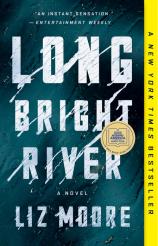Reading Group Guide
Discussion Questions
Long Bright River

1. The author sets LONG BRIGHT RIVER against one city’s experience of the opioid epidemic, informed by her own research. To what degree do you think the drug crisis in Kensington represents the situation in other regions of the United States? Did reading the plight of Kacey, and its impact on her sister and larger family, make you think about the epidemic any differently? How did the portrayal in the book compare with your understanding of the problem from news, or from your personal life?
2. In this novel, the author combines a crime story with a family drama, as she moves back and forth between present and past, and sets it all against a real and researched city and culture. Which elements moved or compelled you most? Did knowing it was influenced by real life make it more or less powerful for you?
3. While Kacey and Mickey grew up in the same house, they followed vastly diverging paths in adolescence. In what ways were the girls different by nature? Or was it a matter of nurture? Which differences do you think most influenced their fates, and why? What impact did these differences have on their relationship as children, and as adults? What do you think the author is ultimately saying about the connection between family and fate?
4. The author explores the pressures that are put on single parents, juggling child care and an unpredictable work schedule. Did Mickey’s life make you see this in a new way? How did you feel about the ways she manages this juggling? What about the ways she manages her child’s relationship with his father? Do you think such pressures would be different for a man?
5. The vividly drawn neighborhood of Kensington plays a crucial role in the book, becoming almost a character itself, with its own history. How does the author’s portrayal of Kensington contribute to the larger story? Consider the different characters’ feelings about this place, its role in their personal lives, histories and struggles.
6. Mickey’s Philadelphia is a melting pot of haves and have-nots. What do we learn about class and privilege, and the way they are manifested in the lives of the characters? Consider in particular the times when social tensions emerge as a result of class. Do any of the characters demonstrate class mobility or the ability to socialize across these carefully drawn lines?
7. How does Mickey’s outlook on justice and the methods and culture of the police department compare with that of her superiors and partners? How do these outlooks compare with your own observations and opinions? In this time of heightened tensions between civilians and police, what do you think about the larger relationship between the police and the community as seen in LONG BRIGHT RIVER? Do you think it’s an authentic portrayal?
8. The author explores the concept of addiction in multiple ways in this story. Beyond the obvious heroin addiction, what other kinds of compulsion do you see? For instance, addiction to work, to the chase, to power, to a certain kind of sex or love or support? What role do these other forms of compulsion play in the story? In what ways is the author interested not just in the effects addiction has on the person suffering from it, but also in the effects on that person’s family and friends and, ultimately, community? Which scenes or relationships show this most powerfully?
9. Over the course of her life, Mickey has had many mentors, including Officer Cleare, Mrs. Powell and even Truman. What impact does each relationship have on the development of Mickey’s character? In what ways do these mentorships dictate her future decisions?
10. Do you think Mickey’s life and profession would have turned out differently if she had been able to go to college as she initially hoped? Would such an education have changed her fate? Why or why not? If not, what would have changed her fate? Or did she end up in the best place for herself, regardless?
11. After their mother, Lisa, dies, Mickey and Kacey are left to live with their grandmother Gee, but Mickey begins to play the role of a pseudo-mother to Kacey. Analyze the mother-daughter relationships presented in the novel: Gee to Lisa; Lisa to Mickey; Gee to Mickey and Kacey; Mickey to Kacey; Mickey to Thomas. How are these parenting styles different, and in what ways are they similar?
12. What is the novel saying about the development of community and the importance of neighbors? Consider the role of Mrs. Mahon in the story, and of the informal network of relationships that Mickey and Truman have with shopkeepers and others on the Avenue. What different types of communities are portrayed in the book?
13. The author launches several mysteries in the course of the story. The biggest and most obvious are established early on: Who is killing young women in the neighborhood, and what has happened to Kacey? Were you surprised by the resolutions of these questions in the end? Were you more surprised by the information that is revealed, or by the way in which it emerged. Did you have competing suspicions or theories?
14. There are also several smaller mysteries or questions propelling the storytelling, such as what is going on with Truman, or with Gee, or with Mickey’s other relatives, or what happened in Mickey’s past to bring her and her child to this new apartment. Some of these are mysteries only to the reader, as certain information is slowly released by the narrative; and some of these are mysteries to Mickey as well. Which unknowns compelled you most, and why? Which surprised you most? Did you see any of the revelations coming, and if so, when and why?







